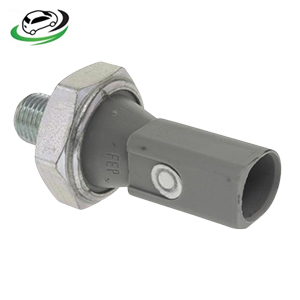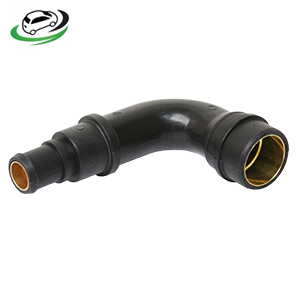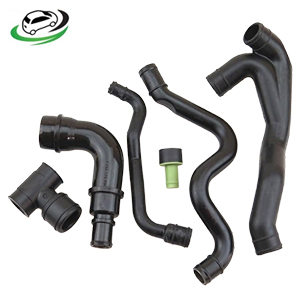-22%
Get Engine Crankcase Breather Hose AUDI A3 8L1/TT 8N3/TT 8N9 / Volkswagen Golf MKIV/1J1 06A103213AF
The engine crankcase breather hose is a vital component of an internal combustion engine’s ventilation system. Often overlooked, this hose plays a crucial role in maintaining the engine’s efficiency, reducing emissions, and ensuring the longevity of the engine. This detailed analysis will explore the function, structure, common issues, and maintenance of the crankcase breather hose.
1. Role and Importance
The crankcase breather hose is an integral part of the Positive Crankcase Ventilation (PCV) system, which was developed to manage the gases that accumulate in the crankcase during engine operation. The crankcase is the housing for the crankshaft and other related components and is located at the bottom of the engine.
During combustion, a small amount of gases, often referred to as “blow-by” gases, escape past the piston rings and into the crankcase. These gases consist of unburned fuel, air, and combustion byproducts like water vapor and carbon dioxide. If left unchecked, the pressure from these gases can build up in the crankcase, leading to several problems, including:
- Increased Oil Consumption: High pressure can force engine oil past seals and gaskets, leading to leaks.
- Oil Contamination: The blow-by gases can mix with engine oil, diluting it and reducing its effectiveness as a lubricant.
- Corrosion and Sludge Formation: The moisture and acidic components in the blow-by gases can cause corrosion and sludge buildup in the engine.
To prevent these issues, the PCV system routes these gases back into the intake manifold, where they are reintroduced into the combustion chamber to be burned off. The crankcase breather hose is the conduit through which these gases travel from the crankcase to the intake manifold.
2. Structure and Functionality
The crankcase breather hose is typically made of durable rubber or heat-resistant plastic, capable of withstanding the harsh conditions under the hood, such as high temperatures and exposure to oil and fuel vapors. The hose connects the crankcase to the PCV valve or directly to the intake manifold, depending on the engine design.
2.1. Components of the System
- Crankcase: The area at the bottom of the engine where the crankshaft operates and where the blow-by gases accumulate.
- PCV Valve: A one-way valve that controls the flow of blow-by gases from the crankcase to the intake manifold. It prevents gases from flowing back into the crankcase when the engine is off or under low load.
- Breather Hose: The conduit that carries the gases from the crankcase to the intake manifold, ensuring they are safely burned off during combustion.
2.2. How It Works
When the engine is running, the blow-by gases in the crankcase create pressure. The PCV valve opens, allowing these gases to flow through the crankcase breather hose and into the intake manifold. Here, the gases are mixed with fresh air and fuel before being drawn into the cylinders for combustion. This process not only reduces the pressure in the crankcase but also helps to reduce harmful emissions by ensuring that unburned fuel and other pollutants are properly burned.
In some engine designs, particularly older ones, the breather hose may also allow fresh air to enter the crankcase to help carry the blow-by gases out. This is known as an “open” PCV system. Modern engines, however, typically use a “closed” PCV system, where all gases are recirculated back into the engine rather than vented to the atmosphere.
3. Common Issues and Symptoms
The crankcase breather hose, while simple in design, can develop issues that can significantly impact engine performance and efficiency. Here are some of the common problems associated with this component:
- Clogged or Blocked Hose: Over time, the breather hose can become clogged with oil sludge, carbon deposits, or debris. This blockage can prevent the proper flow of gases, leading to increased pressure in the crankcase. Symptoms of a clogged hose include increased oil consumption, oil leaks, and reduced engine performance.
- Cracks or Leaks: The breather hose is exposed to high temperatures and chemical vapors, which can cause it to deteriorate over time. Cracks or splits in the hose can allow unmetered air to enter the intake manifold, leading to a lean air-fuel mixture. This can cause rough idling, stalling, and increased emissions.
- Collapsed Hose: In some cases, the hose may collapse under vacuum pressure, restricting the flow of gases. This can cause similar symptoms to a clogged hose, including increased crankcase pressure and oil leaks.
- Faulty PCV Valve: While not part of the breather hose itself, a malfunctioning PCV valve can lead to similar issues. If the valve sticks open or closed, it can cause too much or too little vacuum in the crankcase, leading to a host of engine problems.
4. Maintenance and Replacement
Maintaining the crankcase breather hose is essential for ensuring the proper operation of the engine’s ventilation system. Regular inspections and timely replacements can prevent many of the issues associated with a faulty hose.
4.1. Inspection
Regular inspection of the breather hose should be part of routine engine maintenance. During inspection, look for the following signs of wear or damage:
- Cracks or Splits: Visually inspect the hose for any signs of cracks, splits, or tears. Pay special attention to areas where the hose bends or connects to other components, as these are common points of failure.
- Oil Leaks: Check for any oil leaks around the connections. This could indicate a loose hose clamp or a crack in the hose.
- Blockages: If possible, remove the hose and inspect the interior for any blockages. Sludge or carbon deposits can restrict the flow of gases and should be cleaned out.
4.2. Cleaning
If the hose is clogged but still in good condition, it can often be cleaned rather than replaced. To clean the breather hose:
- Remove the Hose: Carefully disconnect the hose from the crankcase and intake manifold. Note the orientation for reinstallation.
- Clean the Hose: Use a solvent, such as carburetor cleaner or brake cleaner, to dissolve any sludge or carbon buildup inside the hose. You can use a soft brush to help remove stubborn deposits.
- Dry the Hose: Allow the hose to dry completely before reinstalling it. Make sure there is no solvent residue left inside the hose, as this can damage the engine.
- Reinstall the Hose: Reconnect the hose to the crankcase and intake manifold, ensuring it is securely attached and free from any kinks or bends.
4.3. Replacement
If the hose is damaged or excessively clogged, it should be replaced. Here’s a general guide for replacing the crankcase breather hose:
- Locate the Hose: The breather hose is typically easy to find, connecting the crankcase to the PCV valve or intake manifold.
- Remove the Old Hose: Disconnect the hose from its connections at both ends. You may need to loosen hose clamps or other fasteners.
- Install the New Hose: Fit the new hose in place, ensuring it is the correct length and diameter. Secure it with the appropriate clamps or fasteners.
- Test for Leaks: Start the engine and let it run for a few minutes. Check the hose connections for any signs of leaks or air leaks.
5. Impact on Engine Performance and Emissions
A properly functioning crankcase breather hose is essential for optimal engine performance and emissions control. Here’s how it impacts these aspects:
- Engine Performance: By ensuring that blow-by gases are properly vented and recirculated, the breather hose helps maintain the correct air-fuel mixture in the engine. This leads to smoother idling, better throttle response, and overall improved engine performance. A faulty hose can cause issues like rough idling, stalling, and reduced power.
- Emissions Control: The crankcase breather hose plays a key role in reducing emissions by ensuring that unburned fuel and other pollutants in the blow-by gases are re-burned in the combustion process. A malfunctioning hose can lead to increased hydrocarbon emissions, contributing to air pollution and potentially causing the vehicle to fail emissions tests.
6. Advances in Crankcase Ventilation Systems
Modern engines have seen significant advancements in crankcase ventilation systems, driven by stricter emissions regulations and the need for better engine performance. Some of these advancements include:
- Advanced PCV Valves: Modern PCV valves are more sophisticated, with features like heated elements to prevent freezing in cold climates and variable flow rates to match engine load conditions.
- Integrated Breather Systems: Some newer engines have integrated crankcase ventilation systems, where the breather hose and PCV valve are built into the valve cover or other engine components. This reduces the number of external hoses and connections, leading to improved reliability and reduced maintenance.
- Oil Separator Systems: High-performance and turbocharged engines often use oil separator systems to remove oil droplets from the blow-by gases before they are recirculated. This helps reduce oil consumption and prevents oil from contaminating the intake system.
Follow us on Facebook for more parts.



